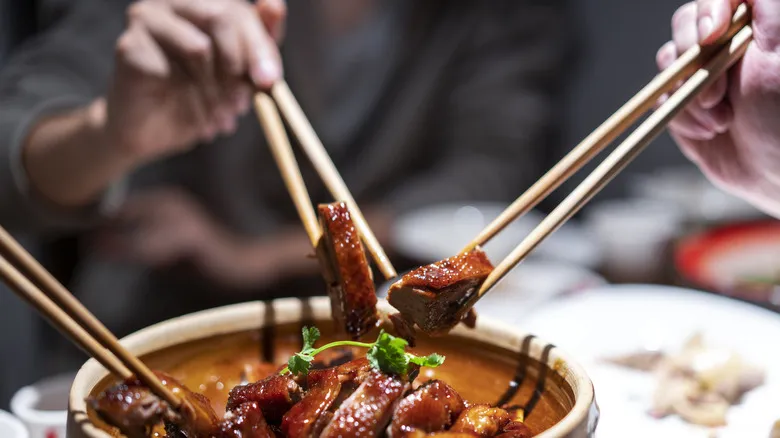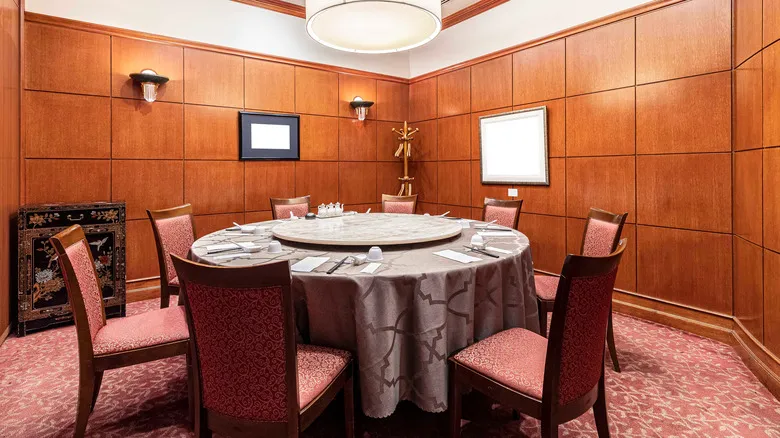Round tables facilitate communal eating

Chinese meals are typically enjoyed in a communal manner at round tables. Diners share dishes from serving platters that are placed on a Lazy Susan in the center. The host usually selects a variety of dishes with different flavors and textures to ensure a delightful dining experience. No one begins eating until the guest of honor, the host, or the eldest person at the table gives the signal or starts the meal.
When the meal begins, it is customary for diners to rotate the Lazy Susan in a clockwise direction to serve themselves more food. Guests are encouraged to bring their plates closer to the Lazy Susan if necessary, rather than reaching over to the communal dishes and using shared utensils to take food from the platters.
Historically, diners would eat directly from the communal platters. They would use their chopsticks to pick up food from the shared dishes and bring it to their mouths. In a single meal, their chopsticks might travel from steamed white rice to deep-fried fish and honey walnut shrimp, finally landing on noodles. Over time, in the interest of promoting healthier communal dining, people began using serving spoons or chopsticks to fill their own plates instead of directly from the communal platters. From that point on, the only food that guests' chopsticks touched was what was on their own plates.
The reunion of family and friends

The round table is deeply rooted in Chinese philosophy and spiritual traditions. In Chinese, "round" is expressed as "yuan," and "tuanyuan" means reunion. Therefore, the unbroken circle of the table symbolizes unity and togetherness, reflecting the gathering of family and friends for a reunion after time apart. Just as the hands of a clock inevitably return to their original position, so too do those who cherish one another. This idea also embodies various meanings, including harmony, prosperity, and abundance.
Moreover, the circle is a shape closely linked to the Tao and the yin and yang symbol. As a result, it holds significant importance during celebratory events in Chinese culture, such as the Mid-Autumn Festival and the Lunar New Year. It is particularly meaningful that people gather around round tables and enjoy circular foods like pineapple tarts, tangyuan (glutinous rice balls), and mooncakes during these festive occasions.
The practical side of round tables

It's reasonable to assert that the popularity of round tables is largely attributed to their user-friendliness as much as to their suitability for special occasions. Many square dining tables can be cumbersome to maneuver, often requiring them to be carried through doorways, up and down stairs, and around tight corners as a single unit. In contrast, round tables are designed so that the tabletop can be detached from the legs, making them easier to handle. Additionally, the Lazy Susan is typically a standalone piece, allowing it to be removed from the table when needed. Those responsible for moving the tables can easily disassemble them for transport.
The wood used for round tables is often more affordable than that used for many rectangular tables. Furthermore, many round tables come with an extra leaf that can be added or removed based on the number of guests expected. This means that form and function complement each other. One of the key advantages of a round table is its ability to accommodate more people for a meal. The table can be adjusted to fit the number of attendees, ensuring that no one has to miss out on a meal due to a lack of seating.
Recommended

The World's First Potato Chip Flavor Is Still A UK Staple

Here's What It Takes To Become A Michelin Star Inspector

What Is Bubble And Squeak? The Classic British Dish Explained

Brazilian Lemonade Is The Creamy Citrus Drink That Requires No Juicing
Next up

